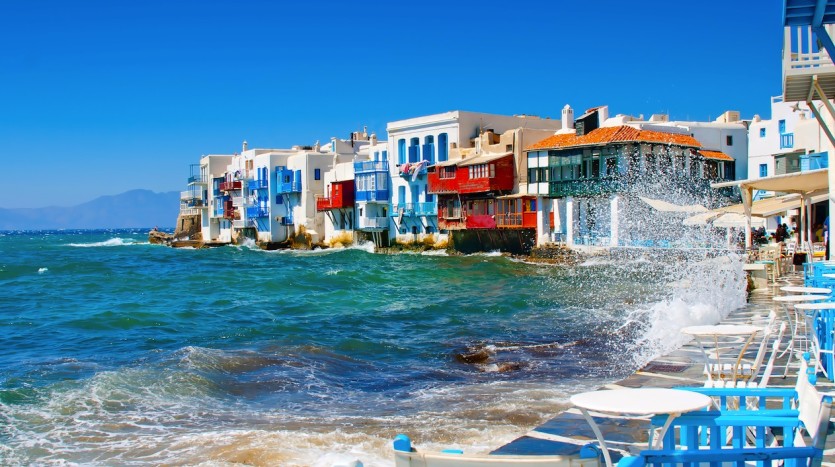MYKONOS
Mykonos is part of a cluster of islands including Delos, Rhenia and some rocky islets. Mykonos, already inhabited since the 5th millennium B.C. (prehistoric settlement of Ftelia), has shared with them a long and copious history with them. Its intense tourist and cosmopolitan activity, which has continiously kept Mykonos in the foreground, inevitably reminds us of the cosmopolitan ancient Delos during the period of its commercial peak (Hellenistic-roman period).
Since the fifties, Mykonos has always been one of the most popular tourist islands of the Mediterranean.
Chora, as the town of Mykonos is commonly known, impresses and casts its spell on the visitor from the first moment, with its beautiful position, scale and architecture. Despite the great tourist development of the island, it manages to maintain its cycladic features and traditional look, like few other towns.
Its cube-shaped, all white houses glow in the sunlight, scattered wisely and orderly in the countless labyrinthine alleys and streets with whitewashed cobbled pavements. A little further, on a low hill, the windmills, having stood for centuries, compose a picture of unparalleled beauty in combination with red domes and bell towers of the countless churches. In the harbour, a small colorful flotilla of caiques and fishing boats completes this unique picture with its vivid colors.
All in all, maintaining the form of the traditional architecture of the Cyclades on the modern buildings ensures a unique feeling of harmony to the town and interior of Mykonos. Nothing can be compared, though, to the emotion inspired by the enthralling space of ancient Delos. A real town with its streets and markets, public buildings and temples, luxurious houses and shops, cisterns, columns, mosaics…

The fame of the island and the large number of visitors, among whom one can recognize some of the most famous personalities all over the world, have resulted in the commercial activity that has made the market of Mykonos so famous.
So, in the streets of Mykonos, most important of which is Matoyianni, one can buy clothes, jewellery and works of art designed by the most celebrated designers and artists. One wouldn’t exaggerate if one said that, quite often, this is where the trends in fashion and style to prevail worldwide are decided.
One can enjoy one coffee, or ouzo with titbit and the traditional tastes at the cafes. Bars and restaurants scattered all around, and observe at the same time, a colorful crowd wandering in the narrow streets of the town.
Chora is also the starting point if you want to discover the rest of the beauties of the island, its picturesque interior and spotless beaches, using a regular bus service or other means of transport.
History

The Kares and Phoenicians may have been the first inhabitants of Mykonos, but Ionians from Athens were established colonists and in control of the island by around 1000 B.C, having expelled the previous occupants. Historical sources confirm the following: in ancient times there were two towns on the island; in 490B.C, the Persian generals Datis and Artaphernes made a brief stopover in Mykonos; It was a poor island with limited agricultural resources. In ancient, pantheistic times, Dionysos, Demetra, Zeus, Appolon, Poseidon and Heracles were the principle gods worshiped here. Later in history the island belonged to the Romans and subsequently to the Byzantines, who have fortified the island against the Arab raids of the 7th century, kept control of it until the 12th century.
After the fall of Constantinople, at the end of the 4th Crusade (1204), the island was occupied, as their seigneur (stronghold) by Andrea and Jeremia Ghisi – relatives of Dandolo, the Doge of Venice. In 1292 it was looted and pillage by the Catalans, and, subsequently, in 1390, given over to the Venetians, in 1390, by the last of the Ghizi overlord. In 1537, while still under Venetian domination, the island suffered a catastrophic attack by Barbarossa, the admiral of Souleiman the Magnificent. Later, under Kapudan Pasha, the head of the Ottoman fleet the island is practically self-governed, according to the system of the period, by a functionary called a “voivode” and a council (body of “syndics”) who always tried to maintain an equal distance from both Turks and Venetians (the last of whom withdrew definitively from the region, in 1718, after the fall of the castle of Tinos to the Ottomans).

The Mykonos, who throughout the same period were known as excellent sailors, were successful in trade and shipping and, also, piracy was not unheard of… Many islanders were active in the “Orlof Insurrection” ( led by the Orloff brothers, 1770-74), which resulted favorably, for them as well as for Catherine the Great in, due to the very profitable treaties concerning trade between the Ottomans and the Russian Empire.
Soon after the out break the Greek Revolution 1821, the Mykonians, roused and led by the lady Mando Mavrogenous (an- aristocrat educated with the most fervent ideas of the Enlightment- who become a popular nation heroine) successfully impeded a landing of a squadron of the Ottoman fleet in 1822. They participated actively in the war , with four armed ships (two of the totally outfitted and supplied at Lady Mando’s expenses ; before the war over she had spend almost all of her , considerable, family fortune).
After the establishment of the modern Greek State, the activity of the local upper- and lower- middle class revived the island economy through the consolidate of trade relations with south Russia, Moldavia and Walachia. Mykonian merchants were established in Constantinople, Smyrna, Alexandria, Syros, Livorno and Marseilles. The predominance of stream technology over the traditional commerce of the sailing ships, at the end of the 19th century, the subsequent opening of the Corinth Canal (1904) and the upheavals of World War I resulted in a depression of the local economy; many Myconians left to find work abroad (mainly in US) and in the going centers of mainland Greece (Piraeus, Athens). The development of tourism in the following decades has provided a means of the islands’ economy development.

Meteorology
The main winds in the area are north with a percentage that reaches 38.2%, followed by the northeast winds with a percentage of 16.3%. The percentage of calm is small and reaches almost 11.3%. The intension of the winds is medium and varies from 2 to 6 Beaufort. The scheme that follows presents the wind graph as it results for the period of 1989-1996.

South Aegean Sea has important climatologic changes due to its geographical position, the size and the distance of the islands from the closest coasts of the mainland. The islands of the Aegean Sea can be differentiated into three groups with similar climatic data:
- Central and South Cyclades (Folegandros, Paros, Milos, Kimolos, Sifnos, Serifos, Syros, Myconos, Naksos, Amorgos, Anafi, Thera, Ios, Sikinos)
- North Cyclades (Kythnos, Kea, Andros, Tinos)
- Dodekanisa
All the islands have mild Mediterranean climate, which in the SE areas tends to be sea climate. The winter is very mild, with average temperature that in many islands of the Cyclades is over 120 C. During summer the average temperature is over 250 C in most of the islands, the atmosphere is still cool though due to the winds and the sea.br> The climatic conditions of the area of the South Cyclades are characterized as favorable for agricultural production. The free of frost period of the year, very important for many plants, is exceptionally large and it lasts from March the 1st till November the 15th, i.e. for 260 days per year. A limiting factor of the production and generally of the agricultural evolution of the island is the extended dry period with low annual average height of rain that ascends to 371,7 mm (for the period 1989-1996).
- source: My mykonos







